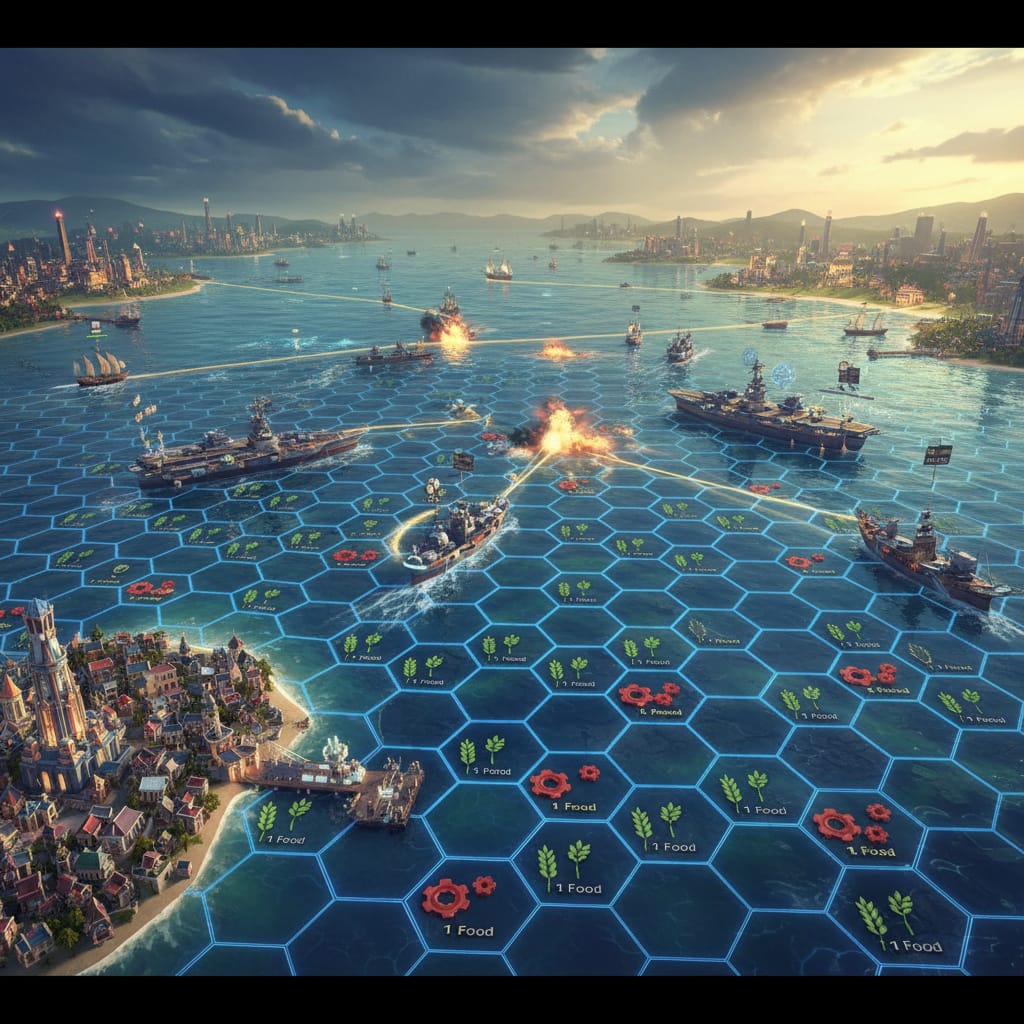In the grand strategy of Civilization VI, few elements are as consistently debated as the value of the sea. Player forums are filled with discussions lamenting “dead” ocean tiles, vast expanses of blue that offer little more than a movement path. For most of the game’s life, a coastal city has been seen as a situational choice, often a compromise, accepted only for a key luxury resource or a strategic naval position. But what if the fundamental nature of the ocean was different? Imagine a world where every single ocean tile, from the shallowest coast to the deepest sea, provided a base yield of 1 Food and 1 Production. This single, seemingly simple change would not just be a minor tweak; it would be a cataclysmic shift, sending strategic shockwaves through every era of the game and fundamentally rewriting the rules of empire-building.
The End of “Coastal Settles are Bad Settles”
According to the player community, the hierarchy of city placement is clear: fresh water is king. A city on a river or a lake gains immediate, powerful housing bonuses, enabling rapid population growth from the earliest turns. The surrounding land tiles, rich with potential for farms, mines, and districts, form the backbone of a thriving city. In this established meta, settling on the coast is often a strategic sacrifice. You trade the immediate growth potential of fresh water for long-term naval access, a trade that many players are hesitant to make.
But with a base yield of 1 Food and 1 Production on every ocean tile, this calculation is turned on its head. A newly founded coastal city would instantly have access to a ring of workable tiles, each providing a balanced output. This immediately solves the two biggest problems of early coastal cities: food for growth and production for buildings and units. The ocean itself becomes a vast, pre-built farm and workshop.
Analysis on forums shows that this would make coastal locations not just viable, but often optimal. The need to settle directly on fresh water would diminish significantly. A city placed on the coast, even with no river in sight, could now grow almost as quickly as its inland counterparts. This would open up vast new areas of the map for early expansion, creating more dynamic and unpredictable starting strategies. The “perfect settle” would no longer be a single tile, but a range of possibilities along the world’s coastlines.
A New Naval Golden Age: The Rise of Maritime Empires
Many professional gamers suggest that this change would be a massive buff to civilizations and leaders with a naval focus. Civilizations like Norway, with its powerful coastal raiding abilities, or England, with its Royal Navy Dockyards, would become top-tier contenders on any map with a significant coastline. Leaders like Gitarja of Indonesia, who already benefits from coastal tiles, would see her advantages magnified enormously.
A popular strategy would be to leverage these newly powerful ocean tiles to create sprawling maritime empires. With every coastal city being a potential powerhouse of food and production, the incentive to build a strong navy and expand across the seas would be immense. The ocean would no longer be a barrier, but a highway for conquest and colonization.
This would also create a new strategic dynamic between naval and land-based powers. A civilization that ignores its navy would be at a constant disadvantage, vulnerable to coastal raids and naval invasions. The control of the seas would become a primary strategic objective, leading to epic naval arms races and decisive sea battles that could determine the fate of empires.
Economic Shockwaves: Trade and Production Rebalanced
The economic landscape of the game would be completely reshaped. The Harbor district, already a strong choice for coastal cities, would become an absolute necessity. With the addition of a Lighthouse, every ocean tile in a city’s borders would now yield a minimum of 2 Food and 1 Production, plus gold. The Shipyard, which adds production to unimproved sea tiles, would become one of the most powerful buildings in the game.
Analysis on forums shows that this would lead to the rise of coastal “super-cities,” economic powerhouses that could out-produce and out-grow even the most fertile inland locations. Sea trade routes, already valuable, would become the lifeblood of the global economy. A network of coastal cities connected by a fleet of traders would generate staggering amounts of gold, funding massive armies and rapid technological advancement.
This economic shift would also have a significant impact on land-locked civilizations. While they would still have their traditional strengths, they would find themselves at a distinct economic disadvantage compared to their coastal rivals. The pressure to secure a coastal city, even a small one, would be immense. This could lead to new and interesting diplomatic and military strategies, as land-locked empires fight for their place on the world stage.
Reshaping Warfare: The Strategic Importance of Sea Control
In the current meta, naval warfare is often a secondary concern. A strong land army can conquer the world without ever building a single ship. But in a world where the ocean is a source of immense wealth and power, this would no longer be the case. The player community speculates that naval warfare would become a central pillar of military strategy.
A popular strategy would be to use a powerful navy to project power across the globe. Fleets of battleships and carriers would not just be for defending coastlines, but for launching devastating amphibious assaults, blockading enemy ports, and controlling strategic chokepoints. The ability to control the seas would be the ability to dictate the terms of any conflict.
This would also force a re-evaluation of land-based military strategies. A large army, no matter how powerful, would be useless if it could not be transported across the ocean to where it was needed. This would place a new emphasis on combined arms tactics, with land, sea, and air forces working in concert to achieve strategic objectives. The result would be a more complex and engaging military simulation, with a greater variety of viable strategies.
The Ripple Effect: Second and Third-Order Consequences
The impact of this change would extend far beyond the initial, obvious effects. Many professional gamers suggest that it would create a series of ripple effects, subtly altering the balance of the entire game.
- Technology and Civics: The value of certain technologies and civics would skyrocket. Cartography, which allows for the creation of the first sea-going units, would become a critical early-game priority. Shipbuilding and the technologies that unlock advanced naval units would be fiercely contested. The civic that unlocks the Naval Infrastructure policy card, which boosts Harbor adjacency bonuses, would be a must-have for any coastal empire.
- World Wonders: The strategic value of certain World Wonders would be completely re-evaluated. The Mausoleum at Halicarnassus, which provides extra yields from Great Admirals, would become a top-tier wonder. The Colossus, with its extra trade route and Great Admiral points, would be a powerful economic engine. Conversely, land-based wonders might see their relative value decrease.
-
Victory Conditions: The path to victory would be altered for every victory type.
- Domination: A powerful navy would be essential for global conquest.
- Science: The high production of coastal cities would be ideal for building Spaceports and completing the science victory projects.
- Culture: Coastal cities with high appeal, boosted by seaside resorts and the Eiffel Tower, could become cultural powerhouses.
- Religion: A strong navy would be necessary to spread religion across the seas and defend against rival apostles and missionaries.
In conclusion, the simple act of adding a base yield of 1 Food and 1 Production to every ocean tile would be a revolutionary change for Civilization VI. It would transform the ocean from a passive backdrop into a dynamic and strategically vital part of the game. Coastal cities would become centers of power, naval warfare would become a central pillar of military strategy, and the entire economic and political landscape of the game would be reshaped. This hypothetical scenario highlights the delicate balance of the game’s design and reveals the immense potential that still lies hidden beneath the waves. It would, without a doubt, create a more vibrant, more competitive, and ultimately more engaging world to conquer.


